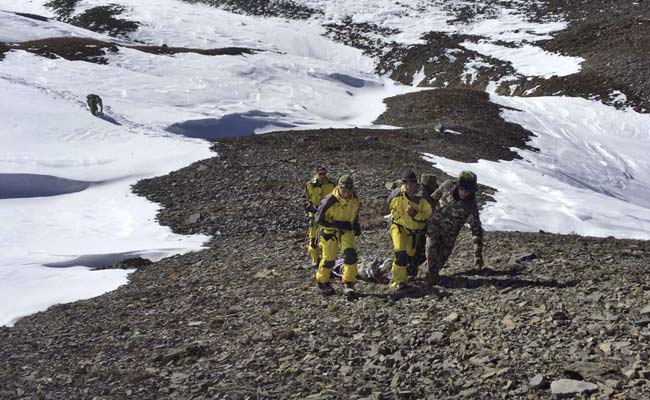
Kathmandu, Nepal:
Freezing, exhausted and blinded by snow, Yakov Megreli,
an Israeli medical student, had a few minutes to make a choice.
He
could spend the night shivering in a flimsy wooden tea stall with a few
others, as snowdrifts crept up the walls outside and began to fall in
through cracks. Or he could press forward into the blizzard with a large
group of trekkers headed toward town and led by the tea shop's owner,
who promised to help them to safety if they each paid him 1,000 rupees,
about $10.
Megreli, 24, cannot quite explain why he stayed behind
in the wooden shack, but that is probably why he was alive Thursday, a
survivor of the worst trekking disaster to hit Nepal's Himalayas in
recent memory.
He and around a dozen other hikers - mostly young
Israelis and Germans - spent the night lying on top of one another,
trying to fight off hypothermia by sharing body heat and talking about
anything they could think of to keep from falling asleep. But they were a
small group. The rest of their group, 40 to 50 young people, decided to
go to the nearest town, Muktinath, he said in an interview from a
hospital in Katmandu. "And we don't know what happened to them."
Around
350 hikers were making their way across the Thorong La pass Tuesday
morning when a ferocious, lashing freak snowstorm - the tail end of a
dying cyclone that had ravaged India's eastern coast - closed in on
them, burying their legs in snow and making their progress down the
steep path to safety agonizingly slow. Of those, 244 reached their
destination, according to Ramesh Dhamala, chairman of the Trekking
Agencies Association of Nepal.
The bodies of seven trekkers, six
of them visitors from other countries, were retrieved Thursday,
according to the association, bringing the number of dead to 27. That
number is expected to rise, because many bodies are presumed to be
buried under several feet of snow. Trekkers who have been rescued have
spoken of passing large numbers of frozen bodies as they hiked out, said
Gopal Babu Shrestha, an official with Trekking Agencies.
Harry
Dahal, a director of Swissa, a tour agency that caters to Israeli
trekkers, said around 100 of his clients were planning to cross the pass
on the day of the storm, and 40 were still missing.
Nepal's army
and police force began rescue operations after dawn on Thursday, and by
nightfall reported more than 70 rescues. Dozens more hikers are safe
but snowbound in remote lodges.
Meanwhile, dazed survivors were arriving in Katmandu's army hospital, wondering at the storm that had engulfed them.
"It
was a terrible experience," Megreli said. "It seemed that everything
was fine. The weather was fine. The trail was not so hard. Until the
storm."
The Annapurna Circuit, as the three-week trekking path is
called, is a popular route for backpackers, nicknamed the Apple Pie
Trek for its famously well-stocked lodges. Guesthouses along the way
provide hikers with thick blankets, yak-dung fires and simple foods like
rice and soup, said David Ways, a travel writer who has made the
journey twice.
Members
of the Israeli group had just crossed the pass and were beginning their
descent toward Muktinath when the wind whipped up, lashing their faces
with snow and making it difficult to see, Dahal said. The path is both
steep and exposed, offering virtually nothing that could serve as
shelter. As the snow accumulated, some hikers found that it was taking
them as long as five minutes to make a single meticulous step, he said,
and some hikers lost their shoes in the snow.
Linor Kajan, a
hiker who survived, said she became separated from her group and got
stuck in a snowdrift, unable to see, until a Nepalese guide she knew
spotted her and "dragged me, really dragged me to the tea shop."
Shrestha,
the Trekking Agencies official, said the sudden, catastrophic storm was
unlike anything he had seen in his 15-year career.
"It was not
snowing when they started to walk down," he said. "Less than one to two
hours later, they could not move. They cannot go back, they cannot go
ahead." After spending Wednesday at the site of the rescue operation, he
said many of those who died had nearly reached Muktinath. Some stumbled
into the town just before dawn Wednesday.
"Everyone was
freezing, everyone was trying to put their feet in the right place,
slowly, slowly," he said. "Everything looks white, and you can't find
the real path."
The blizzard abated Wednesday, and inside the tea
stand, the small group of survivors with Megreli weighed their choices
and finally decided to venture out into the waist-high snow.
They
did so without any certainty that they would be strong enough to reach
the town. "We couldn't see the way, we didn't know the way, and all the
night it was snowing," said Maya Ora, 21, another Israeli hiker.
They
wrote one note that they hoped would reach diplomats from their home
countries and handed it to a Nepalese guide on horseback. And they left a
second handwritten note addressed to whatever stranger would next enter
the building, listing all their names and asking that someone look for
them, Megreli said.
Ora, 21, said they hiked for eight hours
before they were able to get cellphone reception. At that point, they
saw a Nepalese rescue helicopter. Megreli credited the handwritten note,
passed by the man on horseback to an Israeli guide, who then contacted
Israel's ambassador to Nepal. Ora described it as a miracle.
"All
the time I thought, 'I am going to die,'" she said. "This is the moment
when I said: 'It's over. I am going home. I am going to be OK.'"
Megreli
was sitting near her. "Some of us are suffering from little medical
conditions," he said. "We are happy that we are alive. We are OK. We are
exhausted. We don't feel some sensations in the fingers. But everything
is going to be OK."
© 2014, The New York Times News Service





